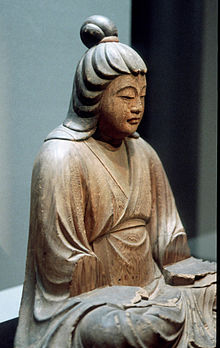Empress Jingū
| Empress Jingū 神功皇后 |
|||||
|---|---|---|---|---|---|

This sculptured image presents an idealized likeness of Empress Jingū (Okinaga-Tarashihime no Mikoto, 1326). Collection of Aka-ana Hachimangū Shrine, Shimane Prefecture
|
|||||
| Empress of Japan | |||||
| Reign | 201–269 (traditional) | ||||
| Predecessor | Emperor Chūai (traditional) | ||||
| Successor | Emperor Ōjin (traditional) | ||||
| Empress consort of Japan | |||||
| Tenure | 192–200 | ||||
| Born | 169 | ||||
| Died | 269 (aged 100) | ||||
| Spouse | Emperor Chūai | ||||
| Issue | Emperor Ōjin | ||||
|
|||||
| Posthumous name | |
|---|---|
| 気長足姫尊 |
Empress consort Jingū (神功皇后 Jingū-kōgō?), occasionally known as Empress regnant Jingū (神功天皇 Jingū-tennō?), was a Japanese empress who ruled beginning in the year 201. The consort to Emperor Chūai, she also served as Regent from the time of her husband's death in 201 until her son Emperor Ōjin acceded to the throne in 269. Up until the Meiji period, Jingū was considered to have been the 15th Japanese imperial ruler, according to the traditional order of succession (hence her alternate title Jingū tennō 神功天皇); but a re-evaluation of the extant historical records caused her name to be removed from that list; and her son, Emperor Ōjin, is today considered to have been the 15th sovereign.
No firm dates can be assigned to this historical figure's life or reign. Jingū is regarded by historians as a "legendary" figure because there is insufficient material available for further verification and study. Jingū's name before her accession to the Chrysanthemum throne is said to have been Okinagatarashi-hime (息長帯比売).
Although the final resting place of this legendary regent/sovereign remains unknown, Jingū's officially designated misasagi or tomb can be visited today at Misasagi-chō in Nara. This kofun-type Imperial tomb is characterized by a keyhole-shaped island located within a wide, water-filled moat.
Kitabatake Chikafusa (1293–1354) and Arai Hakuseki (1657–1725) asserted that she was actually Himiko, the third century shaman-queen of Yamataikoku, and, because Himiko was a historical figure, had to be included as a member of the imperial family by the authors of the Nihon Shoki. Among modern scholars, Naitō Torajirō posits that she is Yamatohime-no-mikoto, while Higo Kazuo suggests that she is Yamato-totohimomoso-hime.
...
Wikipedia
